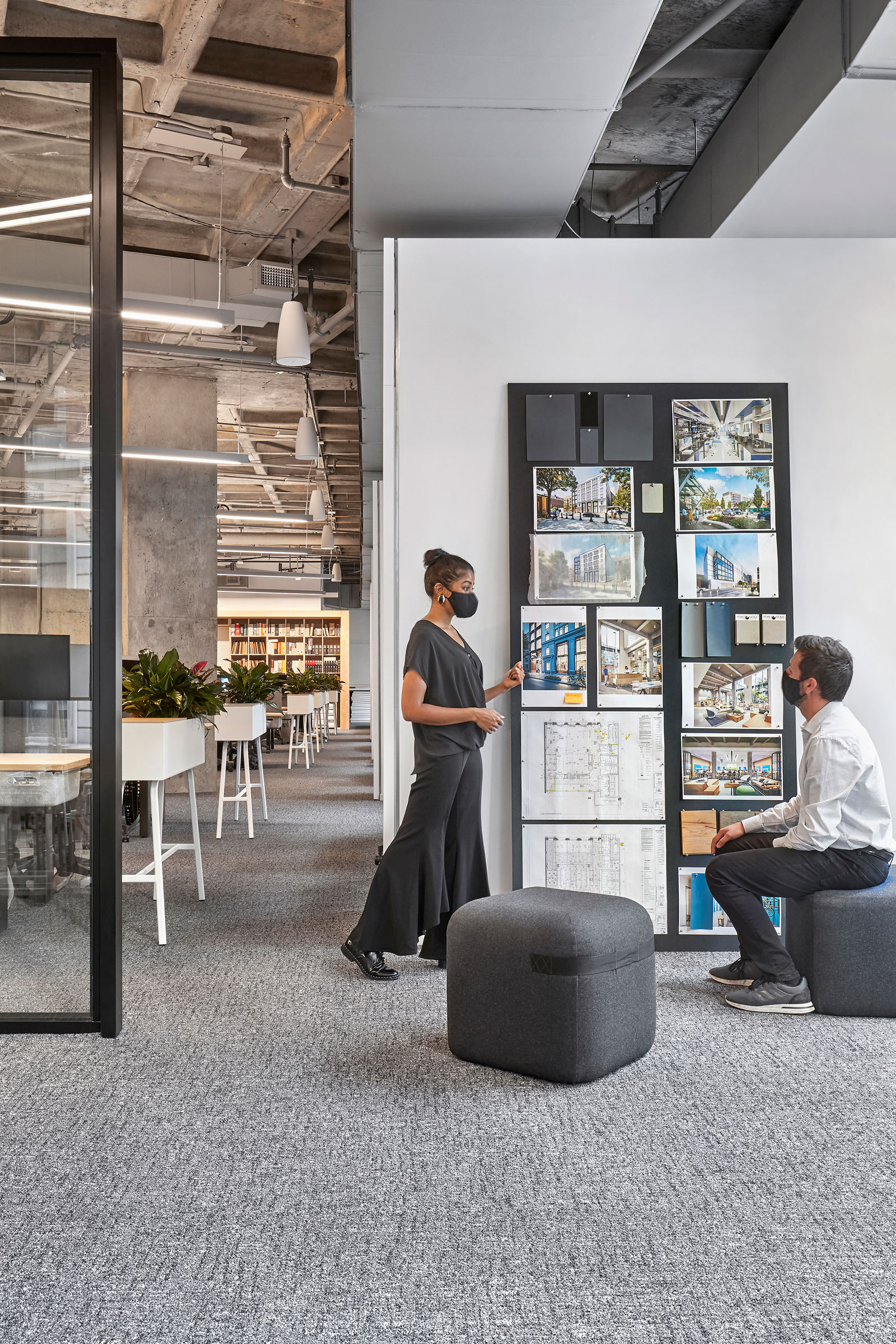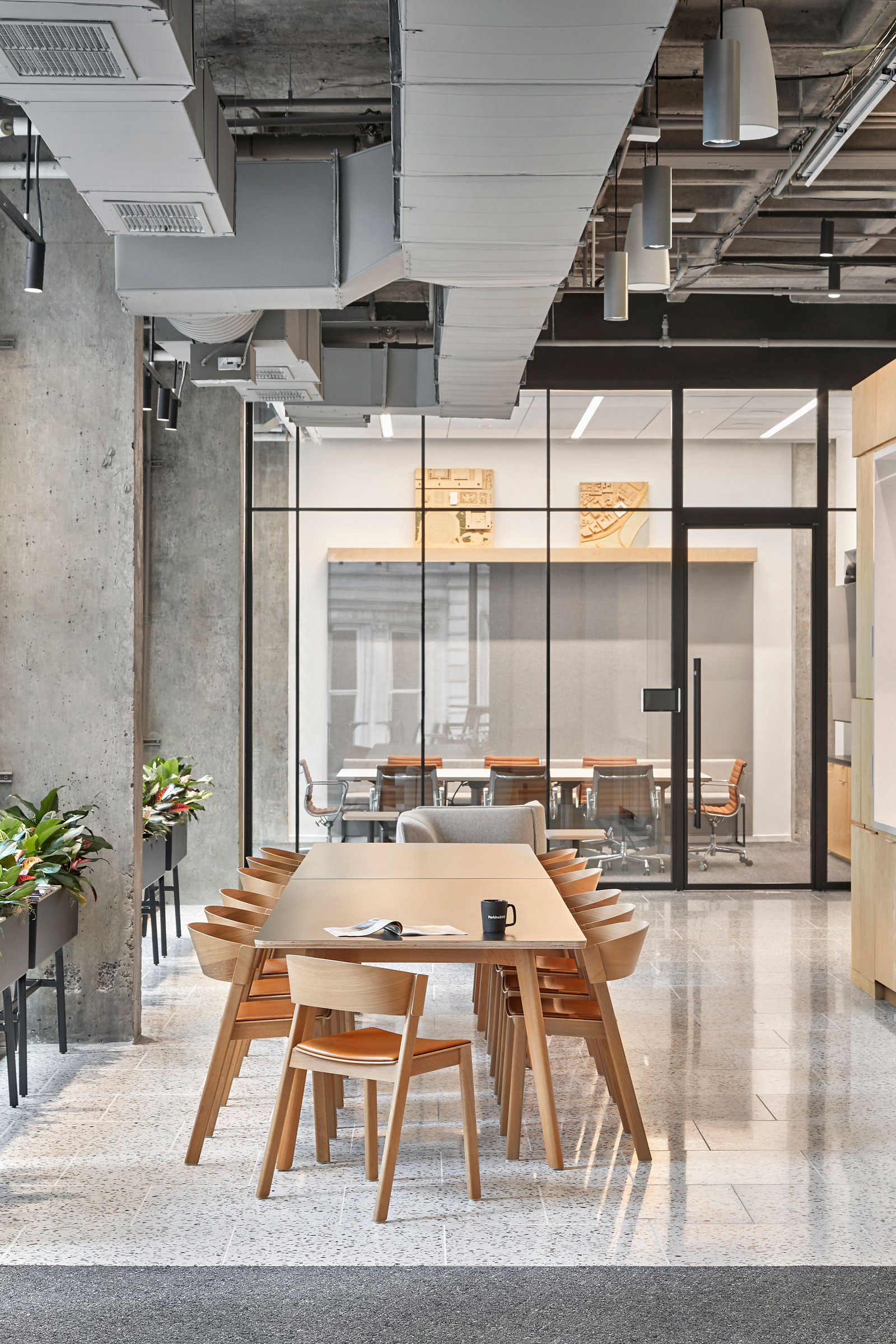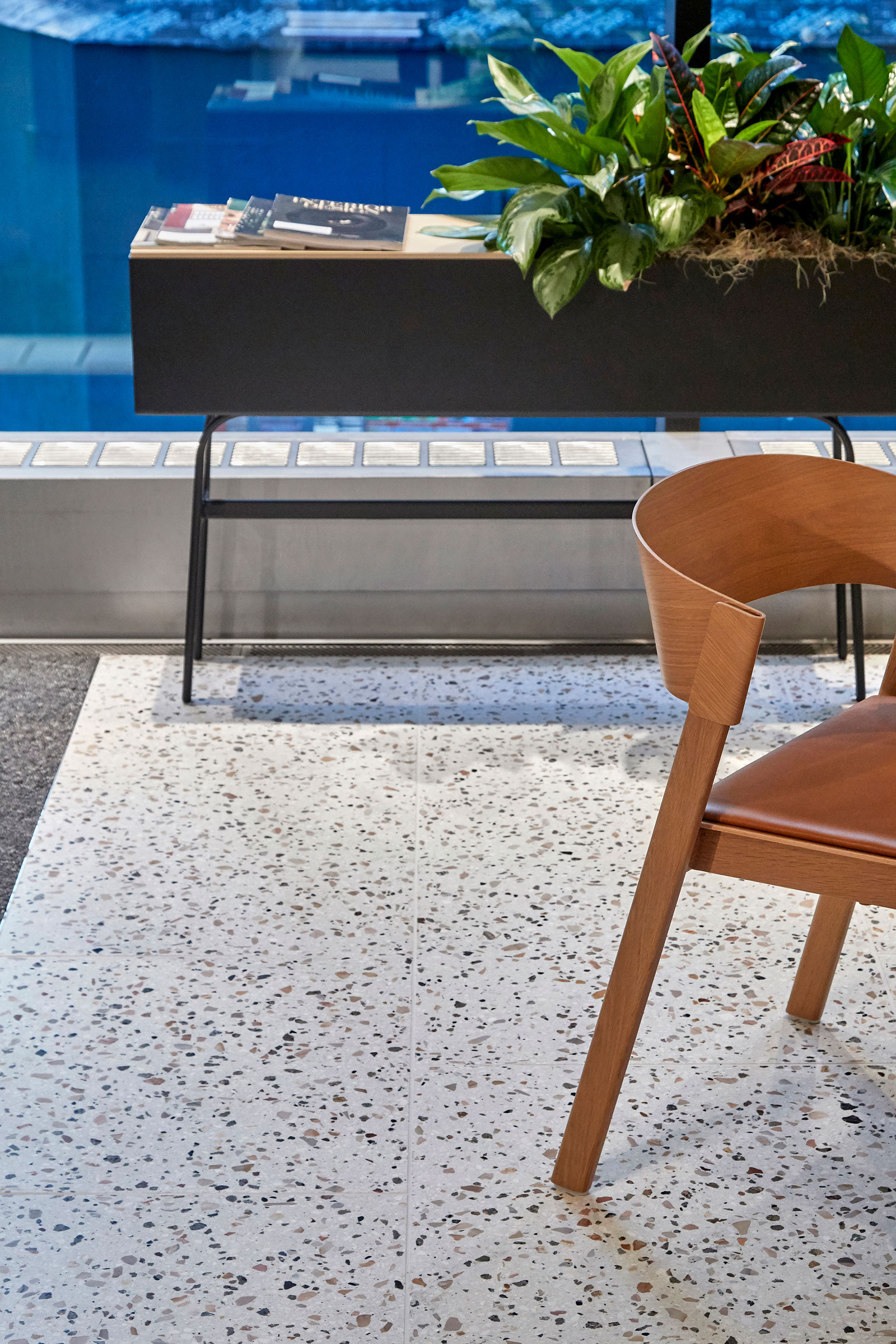Story at a glance:
- Design experts at Perkins&Will share their experience with unassigned seating and redefining office culture.
- Perkins&Will’s new office in NYC’s Nomad Tower opened to limited capacity in fall 2020.
- The firm is experimenting with hybrid design, studying how people use the space and modifying as they go.
No one could have predicted in 2019 just how different the workplace would be in 2020 and beyond. At the time Perkins&Will was deep in planning for its new office in NYC’s Nomad Tower. It would be a living lab. Little did these architects know then just how needed that would be.
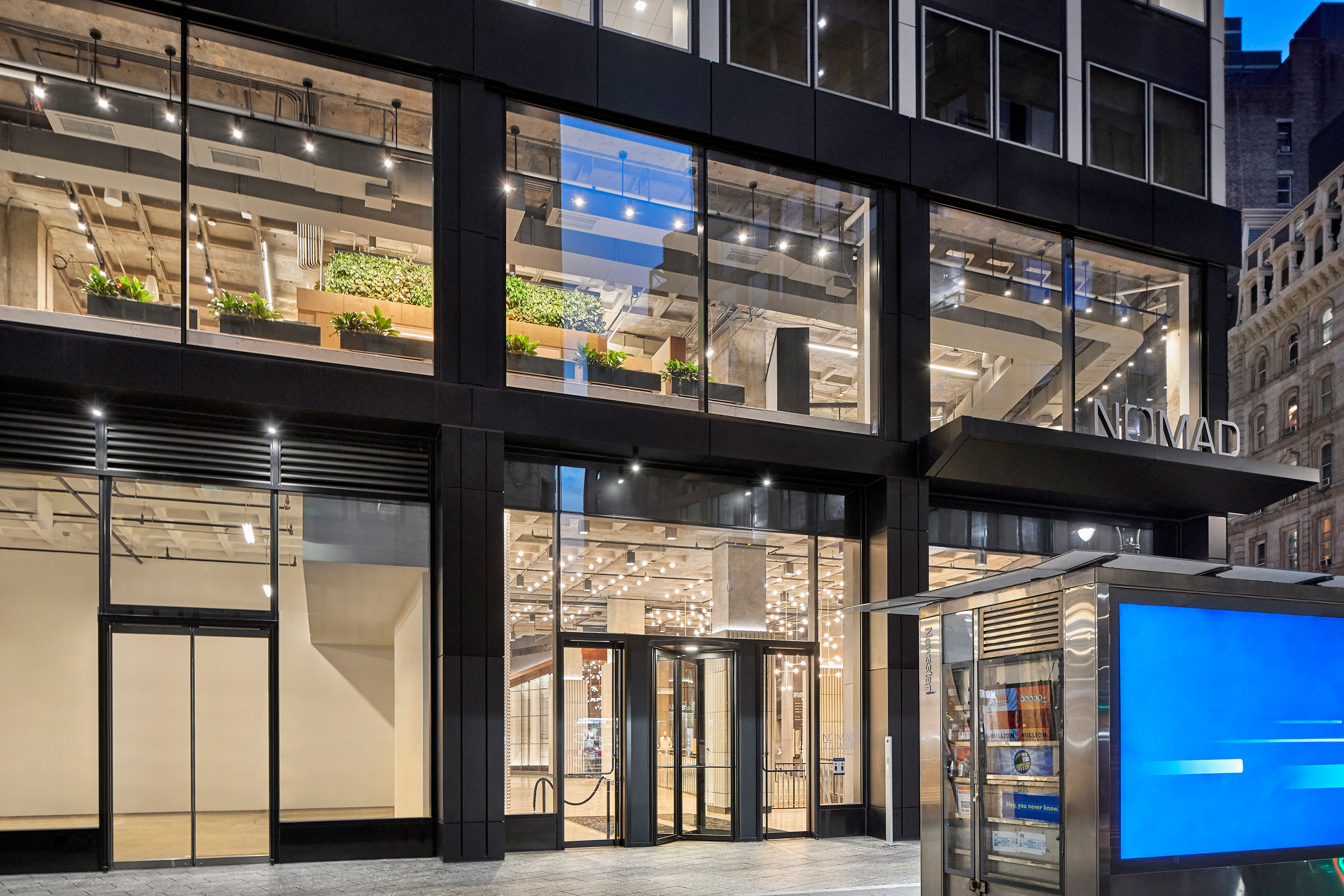
Locating Perkins&Will’s new studio in a second-floor, double-height space normally intended for retail invites the public to see their design process from street-level Broadway, and also engages the team in the pulse of the city street. Photo by Garrett Rowland
The project aimed to predict and react to behavioral, cultural, and technological change in the workplace. Today the Perkins&Will team is testing its design concepts in real time.
“A big part of my involvement has been around understanding the human side of all of this and what this will mean when we get back to work,” says Mariana Giraldo, part of the planning and strategies team at Perkins&Will. Giraldo has been going into the office sporadically since it opened to limited capacity in fall 2020.
As part of the new hybrid work model and phased reopening Perkins&Will is studying the behaviors of its own office. How many people are coming in? When? What activities are they coming in for? Utilization sensors track movement as well as measure light levels, temperature, and CO2—part of the firm’s commitment to sustainability, as the data allows them to optimize the use of things like AC and lighting.
“Even before the pandemic this space was set up to be a continually evolving learning lab,” Giraldo says. “Flexibility was at the core of the design. That doesn’t mean it was planned to be a white canvas, but that we would be able to adjust certain things as we went along.”
Most infrastructure inside the office is not fixed, so spaces can be reconfigured easily, Giraldo says. “We have flexible furniture, a raised floor, and this together with sensors that are measuring how we’re using our space allows us to understand if any adjustments need to be made, like if a space should be used for something else.”
- Photo by Garrett Rowland
- Designed to LEED Gold standards, this project, like all of Perkins&Will’s projects, emphasizes sustainable building materials with high performance and low VOCs. “It’s an exposed structure, and we used a lot of polished concrete where we could,” says Principal and Interior Design Director Brent Capron. Photo by Garrett Rowland
It’s important to note that, while spaces are flexible, they are intentional, says Brent Capron, principal and interior design director. “We didn’t build a space where all our furniture is on casters—come in and do what you want. That’s not the flexibility we’re talking about.” He points to a public area near the front of the office as an example. That space can be intentionally set up to work as an interview space with great lighting for on-camera interviews, or it can be a place to break out and review things digitally, or post work on the wall.
Capron says their new home in Nomad Tower is fitting, considering their own nomadic style and agile working strategy. “Early on we knew we wanted to focus on the process and the work. Our old space did not allow enough of that—not physically allowing enough discourse, not enough live work on the walls. We wanted to make sure we were highlighting that,” he says. “What came out of that was to have a space that was central to the studio, visible from everywhere where people were actively working but working in multiple ways.”
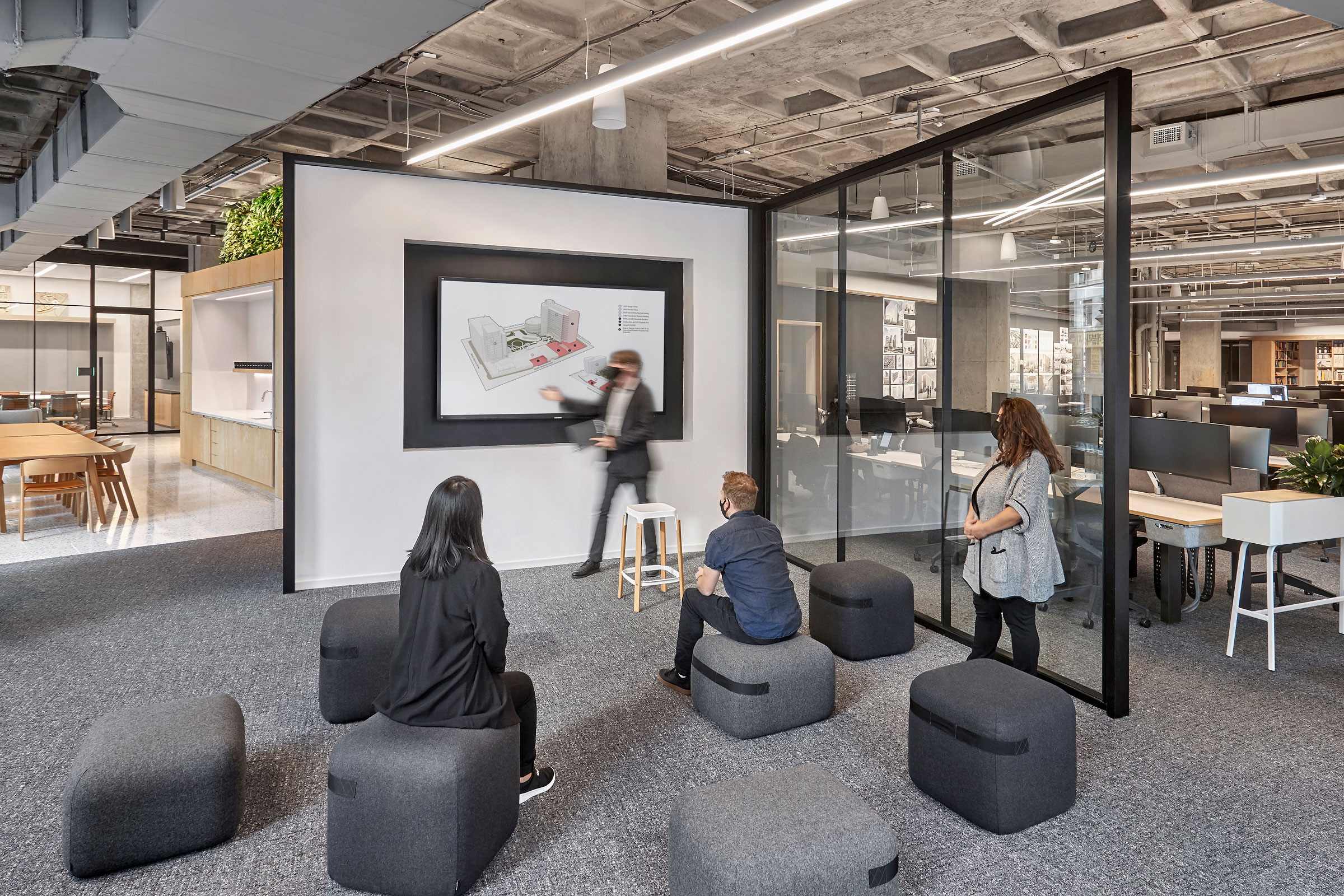
Project zones, dedicated areas for team collaboration, are aligned against floor to ceiling windows and overlook the street below. Photo by Garrett Rowland
Giraldo says the firm’s commitment to technology makes the hybrid model stronger and more inclusive, whether people are in the studio or working from home. Perkins&Will has wall cameras, ceiling cameras that zoom in and out, speakers, and a teleconferencing service hub on wheels you can take where you want and share a touchscreen. “The office is going to be there to support our culture, but we want to make sure people who cannot come in still feel that they are part of the process. Same with our clients. There are ways we can make them feel immersed in the idea or in the essence of our culture and our office.”
A willingness to experiment and commitment to gathering and studying data is in keeping with the firm’s creative mission, Giraldo says, and it will benefit their clients, too. “Design is constantly informed by research,” she says. “Understanding our behaviors and the way we work and what’s at the core of what we do has allowed us to be more resilient.”
Giraldo says the team’s early research showed them they could use real estate more efficiently, and there was a strong argument for unassigned seating. “Initially that felt like a really strong challenge to our culture because we’re used to collaborating and dealing with samples. We’re used to having a lot of stuff, which in a way seemed misaligned with this idea of being agile,” she says.
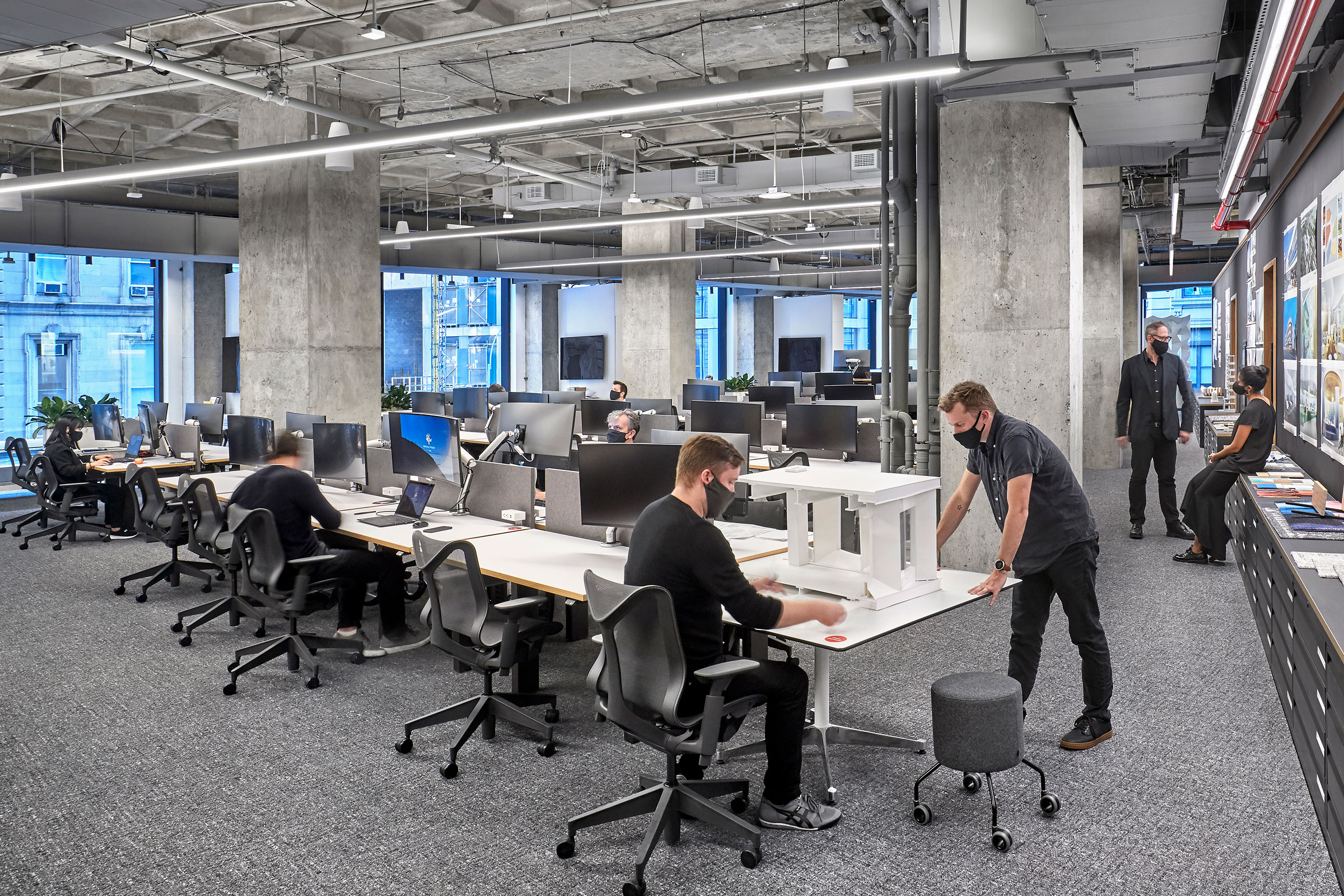
Custom workstations from Innovant and carpet from Mohawk are among the finishing touches in Perkins&Will’s new office. Photo by Garrett Rowland
The team studied what it meant for their processes and their creativity if people didn’t have their own seats. They looked at their natural behaviors, and how often people weren’t using their desks. They asked: What would agile look like for us? What would other spaces look like? How could we be more efficient? Where can we store materials? Personal belongings? “We ended up finding that it’s really the social areas and the collaborative areas that are the bigger part of our work and that the focused areas—the desks—didn’t need to be assigned. What needed to be assigned were the projects.”
They started to rethink space and give projects a home instead of people. The current office has huddle areas where projects can take over for a period of time, with plentiful work boards and pinup walls. The team moves around the projects depending on their activities.
“There’s this balance we’re going to need to figure out in the future between us feeling comfortable sharing space again, like sharing desks, versus what we are coming to the office for, and whether it still makes sense to have an assigned seat,” Giraldo says. “I don’t think we have an answer for that, but what we do have is a model that allows us to test things out, increase our capacity, adjust our schedule, adjust our policies, and adjust the way we’re using those work desks as we move forward.”
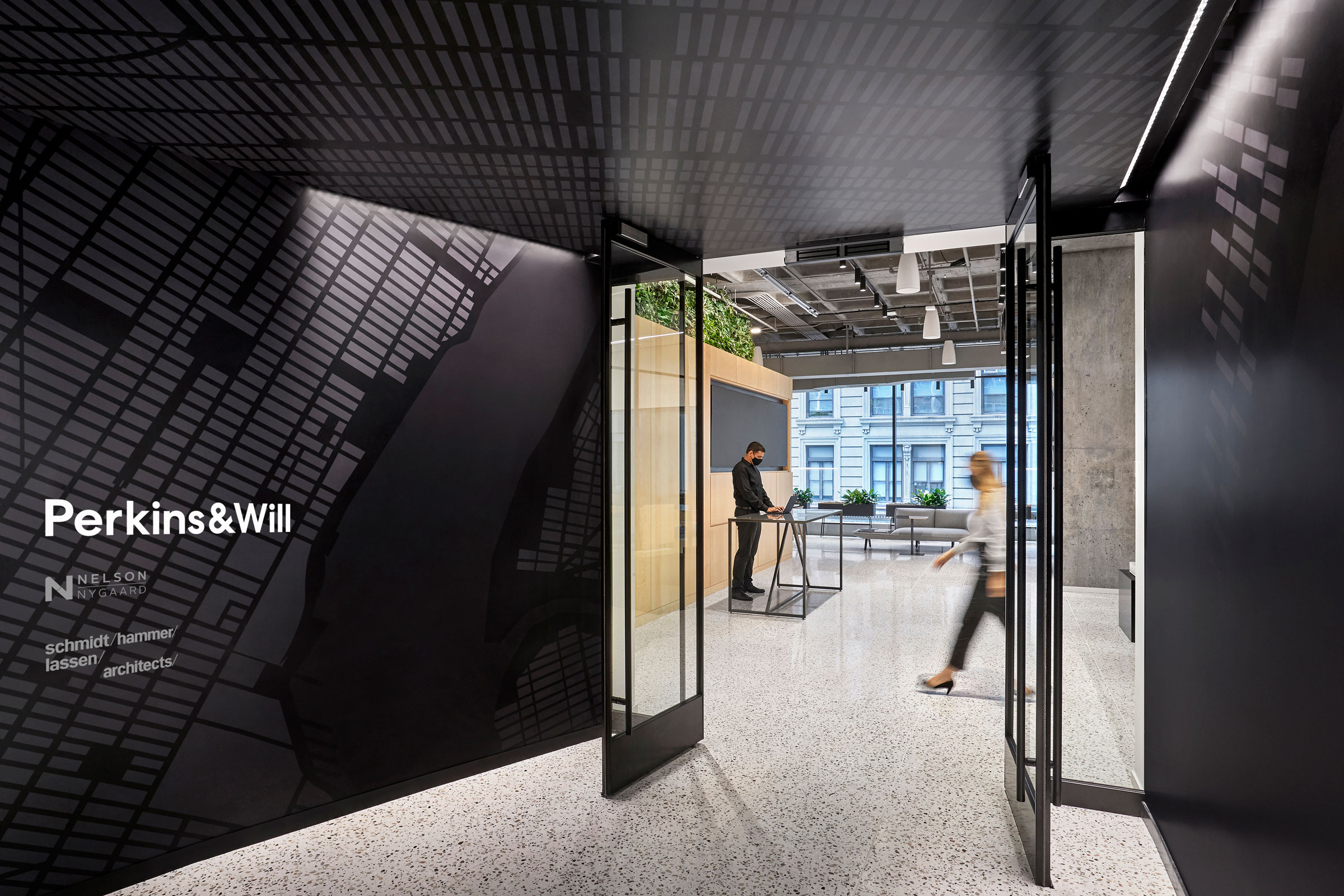
“Even our terrazzo floor tile, which typically you would build on wood substrate, we put that over the system. We tried to look for materials that could be removed and reused when our lease is over, too,” Capron says. Photo by Garrett Rowland
Perkins&Will is committed to looking ahead, predicting what the future workplace may look like and how people will use space. Data from sensors and utilization studies is all part of the ongoing research that will continue to inform their new office, and likely many other offices.
“Is having an assigned seat the best use of real estate? Are there other types of spaces that would better support the way we work?” Giraldo asks. “For the way we work, even though having an unassigned seat was a challenge at the beginning, it made more sense to have more variety in work settings, to have collaboration areas that would allow teams to come together. What is the best use of the space, and how does that end up supporting our culture and our work? That is really what we’re focusing on.”
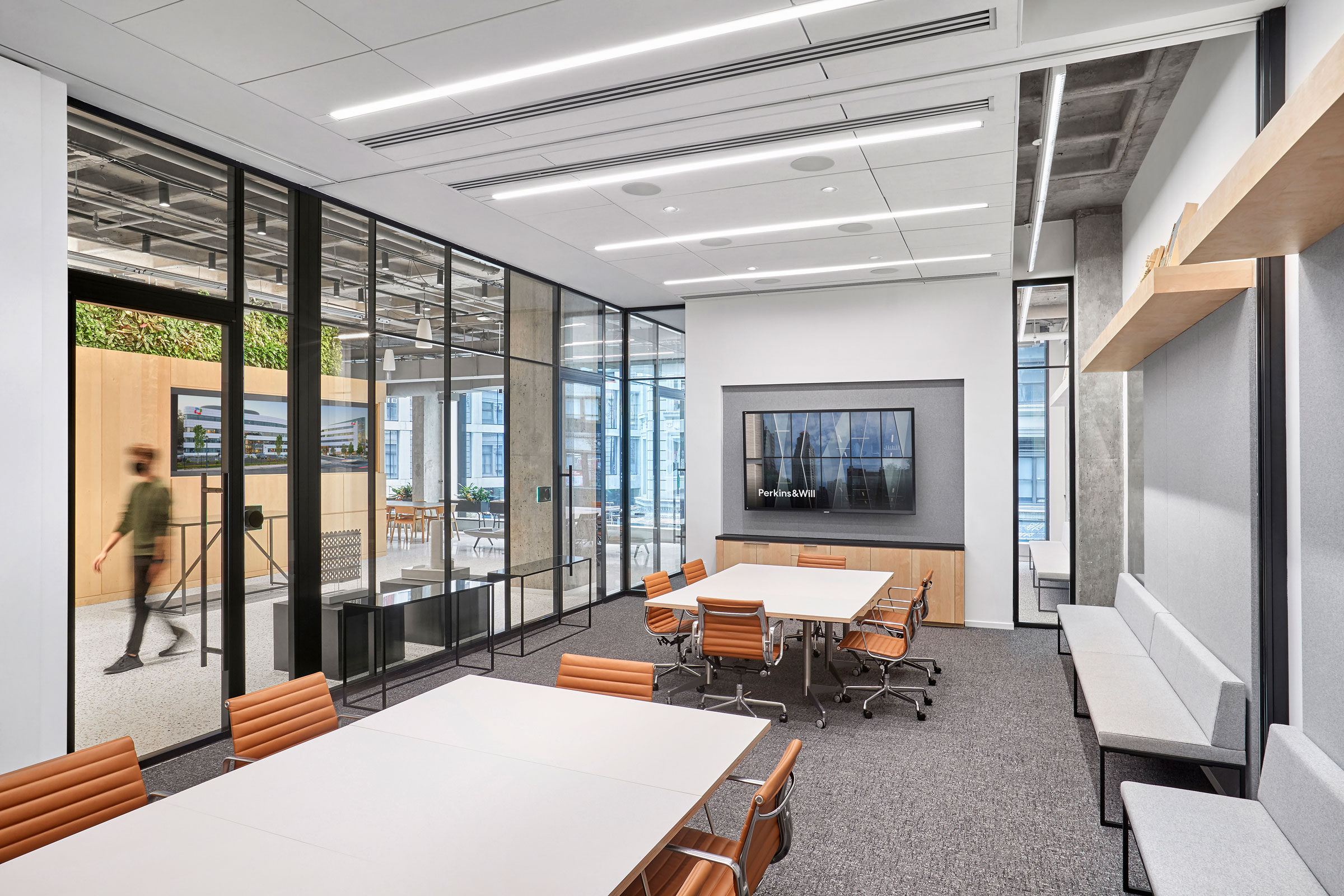
A living wall anchors the division between the client and practice side of the office and is visible from nearly anywhere on the floor. “Not only do we want green in the space, we want people to see green at any point in the day no matter where they’re working.” Flexible planters in furniture-like spaces can easily be moved around. As for the living wall, Principal and Interior Design Director Brent Capron says, “This wasn’t just a visual. We wanted something growing in our space. It visually makes people happier, and it is a natural air refresher.” Photo by Garrett Rowland
While the way we work together may change, the office isn’t going anywhere, Capron says. “We’re always going to find new ways to work together, but we feel the strength of the culture of an office will be even more important,” he says. Daily tasks can be done anywhere, but culture is hard to re-create from home. Perkins&Will is asking what makes company culture different, and how are companies building spaces that support that? How do you support the emotional bond between colleagues?
- Photo by Garrett Rowland
- Photo by Garrett Rowland
“Space will focus even more on the culture, the socialization, and the communication between people and the identity of the company,” Capron says. “I think what’s going to go away are back-of-house offices. If you can do work digitally, why build a space for it? But if you want to commit to being a Googler or you want to commit to being part of a certain law firm, you want to come in and experience that life,” he says. “There’s also something to be said about separating life and work. The workplace isn’t going away. It’s just maybe the 9 to 5 that’s going to continue to erode.”
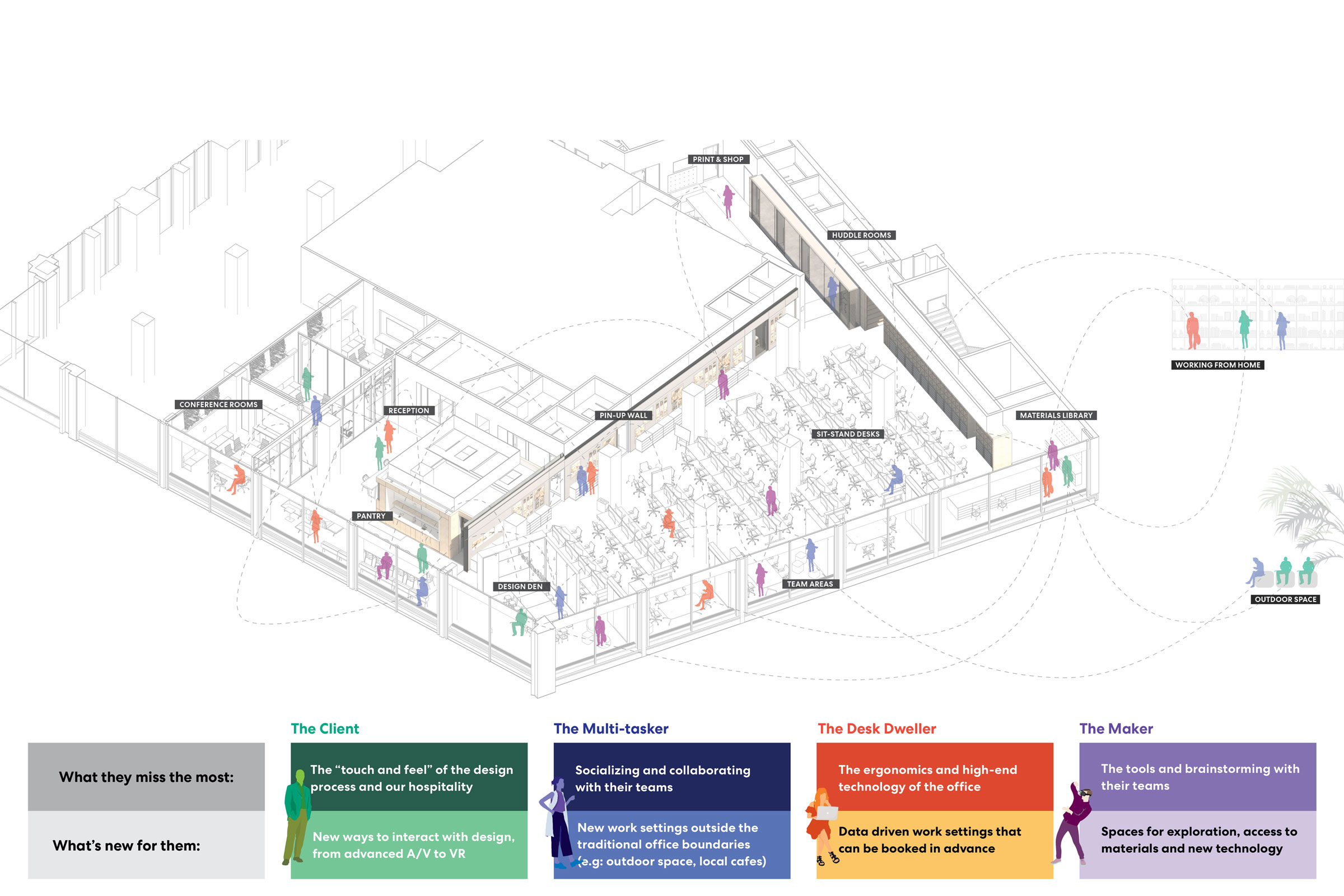
Even before “social distancing” became the norm, Perkins&Will explored a studio design that could both preserve human connection and provide places for more isolated and focused work in the absence of a traditional office setting. Their robust IT/AV infrastructure and resources support agile working while in-studio, and seamlessly transition to enable continued productivity when working remotely. Drawing courtesy of Perkins&Will
Project Credits
Project: Perkins&Will New York studio
Architect: Perkins&Will
Location: New York City
Completion Date: August 2020
Size: 12,000 square feet
Living Wall: Sempergreen
Glass Walls: Tecno Folding
Wall Partitions: Modernfold
Raised Flooring: FreeAxez




